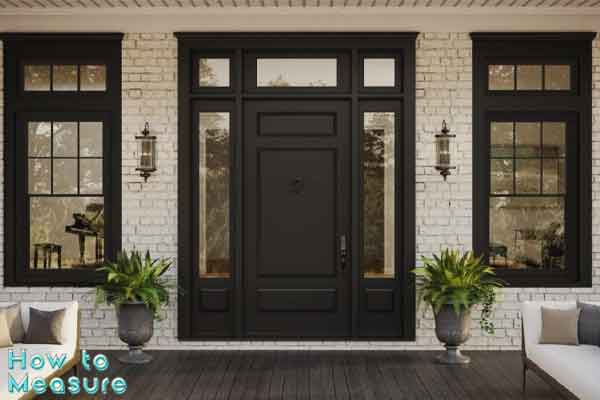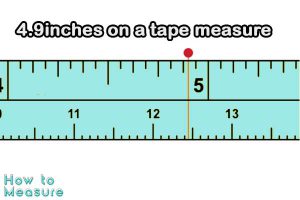Measuring an exterior door can seem like a daunting task, but with the right tools and a bit of guidance, it can be a straightforward process. Exterior doors serve as the primary entrance to your home, providing both security and curb appeal. Measuring accurately is crucial to ensure a proper fit and avoid costly mistakes. In this guide on How to Measure, we will provide step-by-step instructions on measuring for an exterior door, including the tools needed and important considerations to keep in mind. Whether replacing an old door or installing a new one, following these steps will help you achieve a seamless and hassle-free installation process.
Tools needed for measuring an exterior door
When measuring for an exterior door, there are several tools you will need to ensure accuracy. Here are the essential tools you’ll need:
- Measuring tape: A measuring tape is a must-have tool for measuring the height and width of the doorway opening.
- Level: A level will help ensure the door frame is plumb and level before installation.
- Pencil and paper: You’ll need to record your measurements, so having a pencil and paper handy is essential.
- Utility knife: A utility knife is handy for trimming excess material around the doorway.
- Safety glasses are essential when cutting or trimming the door frame.
- Step ladder: You may need a step ladder to reach the top of the doorway opening for measuring purposes.
- Doorstop or wedge: A doorstop or wedge can be used to prop open the door during the installation process.
These tools will ensure that you can accurately measure your exterior door, which is essential for a proper installation.
Measuring for a pre-hung exterior door
Measuring for a pre-hung exterior door involves precise measurements of the doorway opening to ensure a proper fit. Here are the steps you can follow:
- Measure the height: Starting on the left side of the opening, measure from the top to the floor. Repeat this measurement on the right side of the opening. Record the shortest measurement.
- Measure the width: Measure the width of the doorway opening from left to right in three places: the top, middle, and bottom. Record the shortest measurement.
- Measure the depth: Measure the depth of the doorway opening from the front of the interior wall to the back of the exterior wall. Make sure to measure at the opening’s top, middle, and bottom. Record the measurement.
- Measure the rough opening: The rough opening is the distance between the studs on either side of the doorway. Measure the distance between the studs at the opening’s top, middle, and bottom. Record the shortest measurement.
- Add clearance: Add at least 1/2 inch to the height and width measurements to allow for clearance for the door frame and any shimming that may be needed.
- Choose the right door size: Use the measurements you’ve taken to select a pre-hung door that will fit snugly within the rough opening.
By following these steps, you can ensure that you measure accurately for a pre-hung exterior door, which will make the installation process smoother and ensure a proper fit.

Measuring for a pre-hung exterior door
Measuring for a pre-hung exterior door involves taking precise measurements of the doorway opening to ensure a proper fit. Here are the steps you can follow:
- Measure the height: Starting on the left side of the opening, measure from the top to the floor. Repeat this measurement on the right side of the opening. Record the shortest measurement.
- Measure the width: Measure the width of the doorway opening from left to right in three places: the top, middle, and bottom. Record the shortest measurement.
- Measure the depth: Measure the depth of the doorway opening from the front of the interior wall to the back of the exterior wall. Make sure to measure at the opening’s top, middle, and bottom. Record the measurement.
- Measure the rough opening: The rough opening is the distance between the studs on either side of the doorway. Measure the distance between the studs at the opening’s top, middle, and bottom. Record the shortest measurement.
- Add clearance: Add at least 1/2 inch to the height and width measurements to allow for clearance for the door frame and any shimming that may be needed.
- Choose the right door size: Use the measurements you’ve taken to select a pre-hung door that will fit snugly within the rough opening.
By following these steps, you can ensure that you measure accurately for a pre-hung exterior door, which will make the installation process smoother and ensure a proper fit.
Measuring for a standard exterior door size
Standard exterior doors are typically 80 inches in height and 36 inches in width. However, measuring your doorway opening is always best to ensure a proper fit. Here are the steps you can follow:
- Measure the height: Starting on the left side of the opening, measure from the top to the floor. Repeat this measurement on the right side of the opening. Record the shortest measurement.
- Measure the width: Measure the width of the doorway opening from left to right in three places: the top, middle, and bottom. Record the shortest measurement.
- Check the door swing: Stand facing the doorway from outside your home. If the door swings inward, the hinges should be on the left side of the door. If the door swings outward, the hinges should be on the right side of the door.
- Choose the right door size: Use the measurements you’ve taken to select a standard exterior door that will fit snugly within the rough opening. If your measurements don’t match the standard size, you may need to consider a custom-sized door.
By following these steps, you can ensure that you measure accurately for a standard exterior door size, which will make the installation process smoother and ensure a proper fit.
Measuring for a door slab vs. a pre-hung door
Measuring for a door slab and a pre-hung door requires slightly different measurements as the installation process differs. Here are the steps to follow for each:
Measuring for a door slab:
- Measure the height: Starting on the left side of the opening, measure from the top to the floor. Repeat this measurement on the right side of the opening. Record the shortest measurement.
- Measure the width: Measure the width of the doorway opening from left to right in three places: the top, middle, and bottom. Record the shortest measurement.
- Measure the thickness: Measure the thickness of the door jamb on the old door or measure the width of the doorway opening to determine the thickness of the new door needed.
- Choose the right door size: Use the measurements you’ve taken to select a door slab that will fit snugly within the doorway opening.
Measuring for a pre-hung door:
- Measure the height: Starting on the left side of the opening, measure from the top to the floor. Repeat this measurement on the right side of the opening. Record the shortest measurement.
- Measure the width: Measure the width of the doorway opening from left to right in three places: the top, middle, and bottom. Record the shortest measurement.
- Measure the depth: Measure the depth of the doorway opening from the front of the interior wall to the back of the exterior wall. Make sure to measure at the opening’s top, middle, and bottom. Record the measurement.
- Measure the rough opening: The rough opening is the distance between the studs on either side of the doorway. Measure the distance between the studs at the opening’s top, middle, and bottom. Record the shortest measurement.
- Add clearance: Add at least 1/2 inch to the height and width measurements to allow for clearance for the door frame and any shimming that may be needed.
- Choose the right door size: Use the measurements you’ve taken to select a pre-hung door that will fit snugly within the rough opening.
By following these steps, you can ensure that you measure accurately for both a door slab and a pre-hung door, which will make the installation process smoother and ensure a proper fit.
Common mistakes to avoid when measuring for an exterior door
When measuring for an exterior door, there are some common mistakes that you should avoid to ensure that the door fits properly and functions as intended. Here are some common mistakes to avoid:
- Measuring the old door instead of the opening: One common mistake is measuring the old one instead of the opening. This can result in a door that doesn’t fit properly in the opening, which can cause drafts, air leaks, and difficulty opening and closing the door.
- Not measuring in multiple places: It’s important to measure the height and width of the opening in multiple places, especially if the opening is not perfectly square. Please do so to ensure a door fits properly.
- Not accounting for shimming: Shimming may be necessary to ensure the door is level and plumb. Failure to account for shimming can result in a door that doesn’t fit properly or function as intended.
- Adding more clearance: Adding at least 1/2 inch to the height and width measurements to allow for clearance for the door frame and any shimming that may be needed is important. Failure to add enough clearance can result in a door that is too tight or loose in the opening.
- Forgetting to measure the depth: The depth of the doorway opening is important when measuring for a pre-hung door or custom door. Failure to measure the depth can result in a door that doesn’t fit properly.
By avoiding these common mistakes, you can ensure that you measure accurately for an exterior door, making the installation smoother and ensuring a proper fit for your new door.

Conclusion
Measuring an exterior door is important in ensuring that the door fits properly and functions as intended. Whether measuring for a pre-hung door, a custom door, or a standard door size, it’s important to take accurate measurements and avoid common mistakes. By following the steps outlined in this guide and using the right tools, you can ensure that your exterior door fits properly and functions as intended. If you need more confidence in your ability to measure accurately, it’s always a good idea to consult a professional to help you ensure a proper fit for your new door. You can enjoy a well-fitted, functional, and attractive exterior door for years with the right measurements and careful attention to detail.











